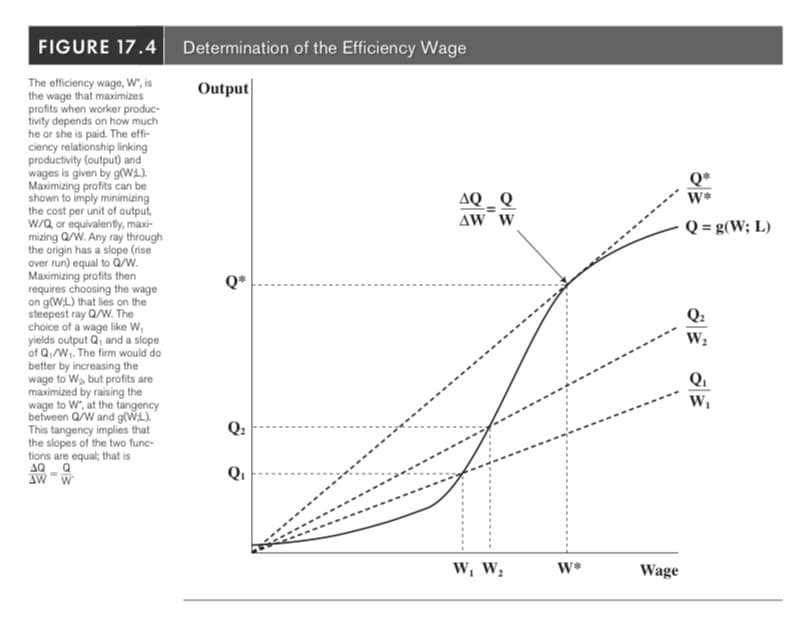Assume that the productivity of farm labour depends on daily caloric intake, similarly to that depicted in Figure17.4. Using this kind of diagram, compare the efficiency wages that would apply to the following two types of workers: • A landless labourer • A labourer with small plot of land on which he grows staple crops Describe the likely equilibrium unemployment rates and wage rates for landless labourers and small landholders. Judging partially on the basis of this example, what sorts of data and what empirical strategies might you use to see whether nutritional efficiency wages were an important element in the rural labour markets of poor, rural economies?
Assume that the productivity of farm labour depends on daily caloric intake, similarly to that depicted in Figure17.4. Using this kind of diagram, compare the efficiency wages that would apply to the following two types of workers: • A landless labourer • A labourer with small plot of land on which he grows staple crops Describe the likely equilibrium unemployment rates and wage rates for landless labourers and small landholders. Judging partially on the basis of this example, what sorts of data and what empirical strategies might you use to see whether nutritional efficiency wages were an important element in the rural labour markets of poor, rural economies?
Chapter11: Profit Maximization
Section: Chapter Questions
Problem 11.8P
Related questions
Question
Assume that the productivity of farm labour depends on daily caloric intake, similarly to that depicted in Figure17.4. Using this kind of diagram, compare the efficiency wages that would apply to the following two types of workers:
• A landless labourer
• A labourer with small plot of land on which he
grows staple crops
Describe the likely equilibrium unemployment rates and wage rates for landless labourers and small landholders. Judging partially on the basis of this example, what sorts of data and what empirical strategies might you use to see whether nutritional efficiency wages were an important element in the rural labour markets of poor, rural economies?

Transcribed Image Text:FIGURE 17.4 Determination of the Efficiency Wage
Output
The efficiency wage, W", is
the wage that maximizes
profits when worker produc-
tivity depends on how much
he or she is paid. The effi-
ciency relationship linking
productivity (output) and
wages is given by g(WL).
Maximizing profits can be
shown to imply minimizing
the cost per unit of output,
W/Q, or equivalently, maxi-
mizing Q/W. Any ray through
the origin has a slope (rise
over run) equal to Q/W.
Maximizing profits then
requires choosing the wage
on g(WL) that lies on the
steepest ray Q/W. The
choice of a wage like W₁
yields output Q, and a slope
of Q₁/W₁. The firm would do
better by increasing the
wage to W₂, but profits are
maximized by raising the
wage to W", at the tangency
between Q/W and g(WL).
This tangency implies that
the slopes of the two func-
tions are equal; that is
AQ Q
AW W
Q*
Q₂
Q₁
AQ_Q
ᎪᎳ Ꮃ
W₁ W₂
W*
Wage
Q*
W*
Q = g(W; L)
Q₁
W₁
Expert Solution
This question has been solved!
Explore an expertly crafted, step-by-step solution for a thorough understanding of key concepts.
Step by step
Solved in 3 steps with 1 images

Knowledge Booster
Learn more about
Need a deep-dive on the concept behind this application? Look no further. Learn more about this topic, economics and related others by exploring similar questions and additional content below.Recommended textbooks for you

